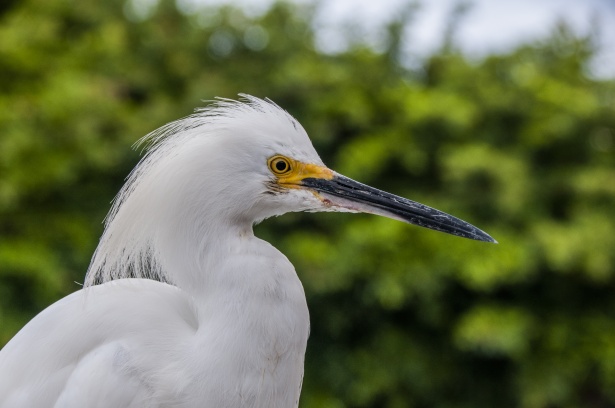ANIMAL: Snowy Egret Egretta thula Type of Animal: Heron Habitat: Wetlands, marshes, swamps, ponds, shallow water inlets, shores/shorelines, sheltered bays in coastal areas, wet/dry fields, coastal areas/islands, tidal flats, lakes/lakesides, mangroves, intertidal zones, tree areas, shrub areas, thick vegetation on barrier islands, thick vegetation on dredge-spoil islands, saltmarsh islands, estuaries, saltwater lagoons, shallow bays, tidal channels, riverbanks, pools, beaches, shallow reefs, mudflats, flooded rice fields, wet grassy meadows, low-lying large river mouths, utilizes fresh, brackish, & salt water Location(s): Range from S Canada to S South America. Also found in Caribbean. Vagrant in Iceland, British Isles, & Azores. Appearance: All white except for yellow lore (yellowish-reddish in breeding season) between long pointed black bill, black legs, orange-yellow feet in breeding season, greenish-yellow feet for most of year, shaggy plumed neck/nape, long wispy feathers on back/neck/head more noticeable in breeding season, juveniles have duller greenish legs Food/Diet: Fish, crustaceans, insects, amphibians, reptiles, snails, worms, rodents, aquatic vegetation Status in Wild: Stable Conservation: Breeding in zoos, aquariums, & wildlife centers. Protected under Migratory Bird Treaty Act. Lifestyle: Colonies/heronries of 20-80 birds. Social feeders/roosters as well, w/ groups ranging from 20-80 birds. Additional Info: Called: Male: Cock Female: Hen Young: Chick Group: Heronry Weight: 13.1 oz Gestation: 3 weeks Life Span: 10-15 years Height: 1.84-2.2 ft Body Length: 1.84-2.2 ft Main predators are crocodilians, snakes, raptors, procyonids, felids, bears, canids, mustelids, crows, & snapping turtles. They have 3.28-3.4 ft wingspan. Numbers became dangerously low in late 1800s/very early 1900s due to hunting for plumes, which women wore on hats. Trade ended in N America in 1910. Often colonially nest w/ other wading bird species. Stalk prey in shallow water, often running/shuffling feet, flushing prey into view by swaying heads/flicking wings/vibrating bills. Sometimes they hover by flying w/ feet right above surface. They’ll also stand still & wait. Often forage w/ other wading bird species. At colony, male establishes nesting territory/builds nest, he then attracts female w/ courtship display involving dipping up/down, bill raising, aerial displays, diving, tumbling, & calling. Female finishes nest construction w/ materials from male. Females lay 2-6 eggs per clutch & nest siblicide not uncommon w/ bigger chicks killing smaller chicks. Fun Fact(s): Sometimes hybridize w/ other heron species like Cattle Egrets, Little Blue Herons, & Tricolored/Louisiana Herons. It’s possible nesting pairs can’t recognize each other out of nest & returning birds need to perform elaborate greeting ceremony lest they get attacked as intruders.

